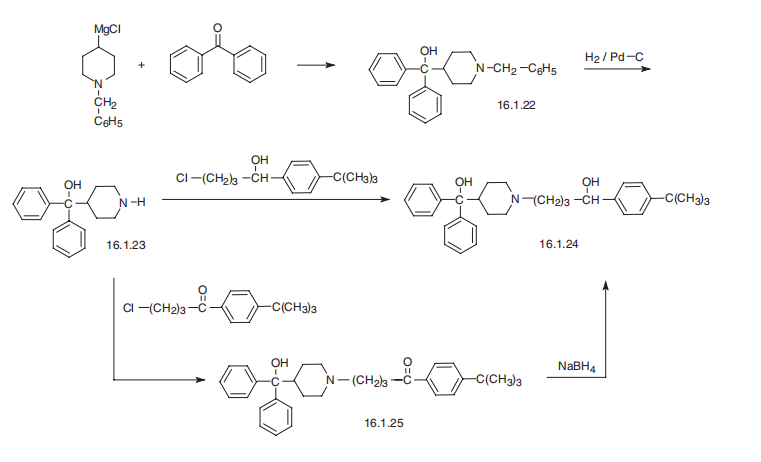|
| | Terfenadine Basic information |
| | Terfenadine Chemical Properties |
| Melting point | 145-152 °C | | Boiling point | 572.76°C (rough estimate) | | density | 1.0488 (rough estimate) | | refractive index | 1.6310 (estimate) | | storage temp. | 2-8°C | | solubility | chloroform: soluble250 mg plus 5 ml of solvent, clear to very slightly hazy, colorless to faintly yellow | | form | neat | | pka | pKa 9.21(H2O
t = 25
I = 0.025) (Uncertain) | | color | White to Off-White | | Water Solubility | 0.001 g/100 mL (30 ºC) | | CAS DataBase Reference | 50679-08-8(CAS DataBase Reference) | | NIST Chemistry Reference | Seldane(50679-08-8) |
| | Terfenadine Usage And Synthesis |
| Chemical Properties | White Solid | | Originator | Histafen,Berk | | Uses | Nonsedating-type histamine H1-receptor antagonist. Antihistaminic | | Uses | H1 antihistamine | | Uses | It is used for relieving symptoms associated with seasonal allergic
rhinitis and conjunctivitis, for angioneurotic edema and allergic skin reaction, and also
as an ingredient of complex therapy for bronchial asthma. Synonyms of this drug are seldane,
hystadin, trexil, and others. | | Uses | Terfenadine has been used to study the role of histamine in itch related to proteinase-activated receptors (PARs) in mice. Terfenadine has also been used to block histamine receptor type 1 to study the pathogenesis of 2,4-dinitrobenzene sulfonic acid (DNBS)-induced ulcerative colitis in rats. | | Definition | ChEBI: Terfenadine is a diarylmethane. | | Manufacturing Process | A mixture of 107 g (0.4 mole) of α,α-diphenyl-4-piperidinemethanol, 105 g
(0.44 mole) of 4'-tert-butyl-4-chlorobutyrophenone, 70 g (0.7 mole) of
potassium bicarbonate, and a small amount of potassium iodide in 600 ml of
toluene was refluxed and stirred for 2.5 days then filtered. The filtrate was
treated with charcoal, filtered through celite then treated with ethereal HCl.
The resulting solid was recrystallized from methanol and isopropyl alcohol to
give the 4'-tert-butyl-4-[4-(α-hydroxy-α-phenylbenzyl)piperidino]-
butyrophenone hydrochloride, melting point 234°-235°C.
To a mixture of 4.2 g (0.0083 mole) of 4'-tert-butyl-4-[4-(α-hydroxy-α-
phenylbenzyl)piperidino]-butyrophenone hydrochloride and 0.54 g (0.01 mole)
of sodium methoxide in 25 ml of methanol is added 2.16 g (0.04 mole) of
potassium borohydride. The reaction mixture is stirred overnight, diluted with
water and the methanol removed under reduced pressure. The remaining
material is extracted with chloroform, washed with water, dried over
magnesium sulfate and filtered. The filtrate is concentrated, and the residue is
recrystallized from acetone-water to give 4-[α-(p-tert-butylphenyl)-α-
hydroxybenzyl]-α-phenyl-1-piperidinebutanol, melting point 161°-163°C. | | Brand name | Antifen;Fenadin. | | Therapeutic Function | Antihistaminic, Bronchodilator | | World Health Organization (WHO) | The first clinically interesting histamine H-receptor1 antagonists
were introduced in the late 1940s and early 1950s. Several H-antihistaminics have
a similar cardiac effect to that seen with astemizole1 and terfenadine. Serious
cardiovascular adverse reactions have been reported when used concomitantly
with imidazole antifungals and macrolide antibiotics. See also under astemizole. | | Biological Activity | Histamine H 1 receptor antagonist. Also blocks hERG and K ATP channels (IC 50 values are 204 nM and 1.2 μ M respectively). Inhibits the delayed rectifier K + current (I Kr ) in guinea pig ventricular myocytes (IC 50 = 50 nM). Activity prolongs QT and induces Torsades de pointes (TdP); cardiotoxic in vivo . | | Biochem/physiol Actions | Non-sedating second generation H1 histamine receptor antagonist. Mainly metabolized by Cyp3A4, 5, 7. Inhibits CYP2C8. | | Pharmacology | Terfenadine not only differs from the other antihistamine drugs in its chemical structure,
but also in that its action begins within 1–2 h and last approximately 12 h, reaching its
peak of action in 3–4 h. | | Synthesis | Terfenadine, |á-(4-tert-butylphenyl) -4-hydroxydiphenylmethyl)-
1-piperidinebutanol (16.1.24), is synthesized in two ways. According to the first, benzyl-4-
magnesiumchloropiperidine is reacted with benzophenone, giving (1-benzyl-4-piperidyl)
diphenylcarbinol (16.2.22), which undergoes further debenzylation by reduction with
hydrogen using a palladium over carbon catalyst, giving (4-piperidyl)diphenylcarbinol
(16.2.22). This product is alkylated by either 1-(4-tert-butylphenyl)-4-chlorobutanol, which
forms terfenadine (16.1.24), or by alkylating with (4-tert-butylphenyl-3-chloropropiophenone,
which forms the product (16.1.25), the carbonyl group of which is reduced to an alcohol
group, thus giving the desired terfenadine (16.1.24). 
| | storage | Store at +4°C |
| | Terfenadine Preparation Products And Raw materials |
|



